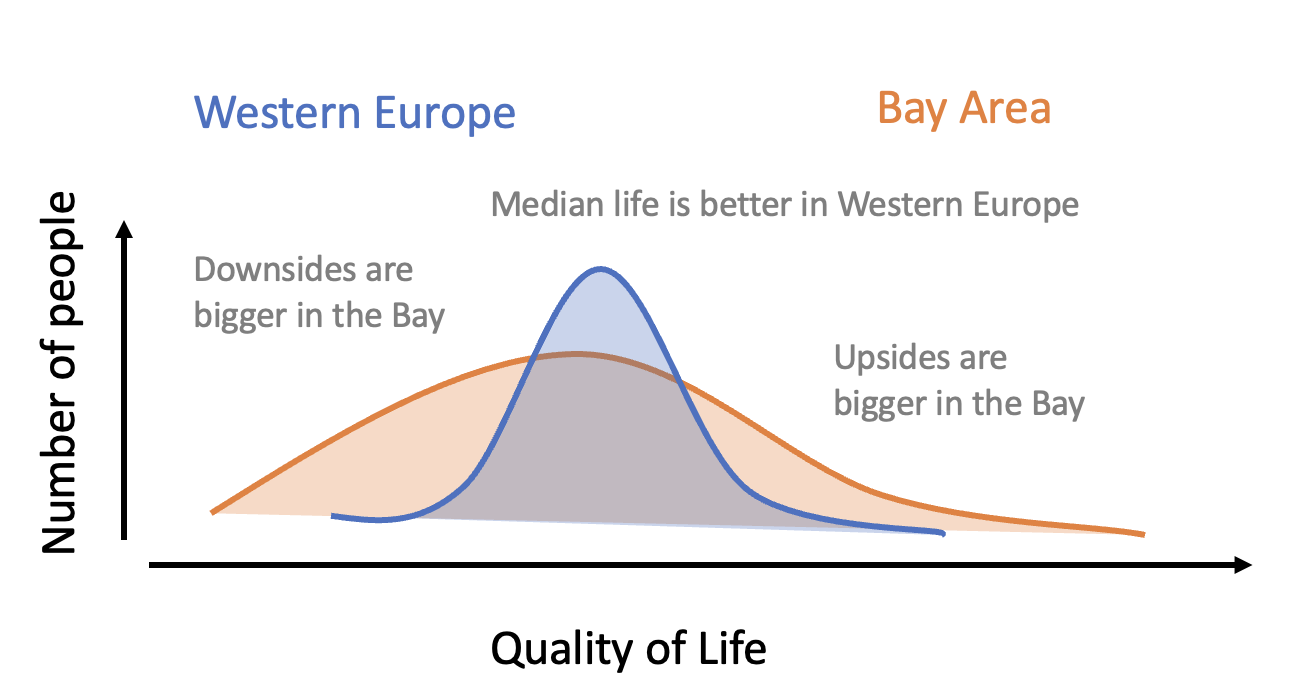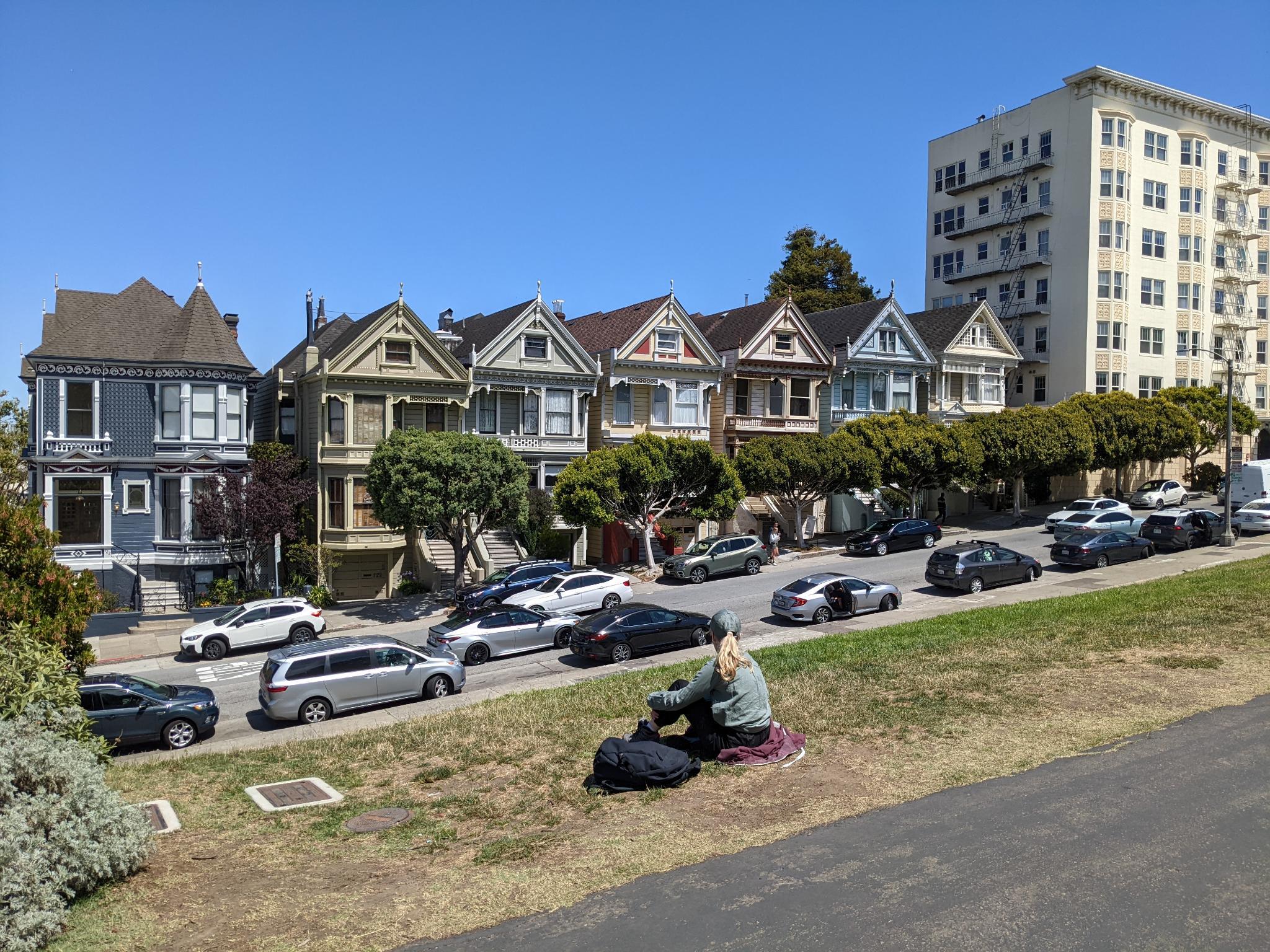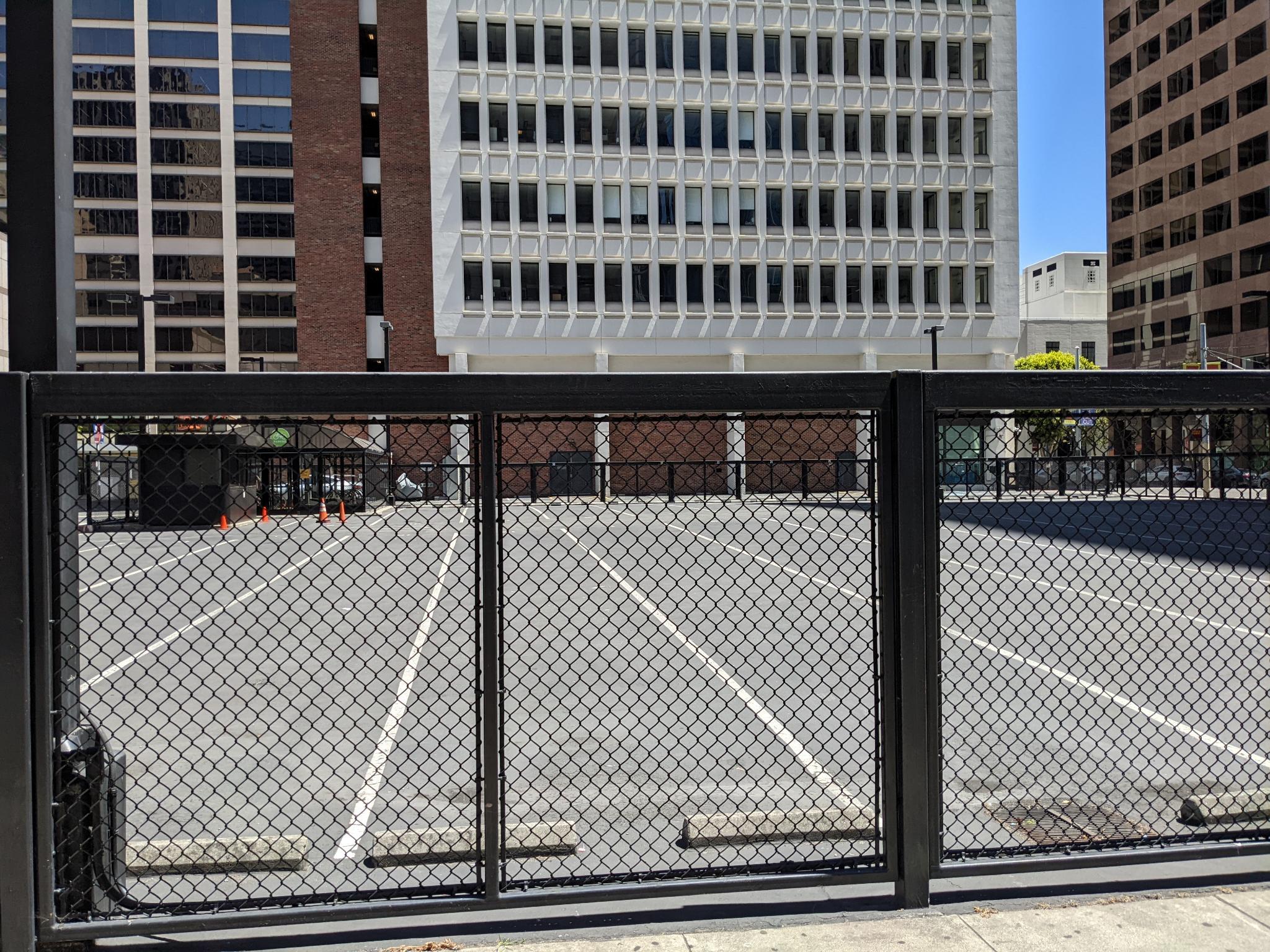what is this post about?
For EAG SF 2022, I have spent ~10 days in Berkeley and SF. Here are some rough thoughts. It has only been 10 days, so it’s likely I would change my mind on many things if I were there for longer.
Summary

- In the US everything seems to have higher variance than in Western Europe. The potential upsides are higher but so are the potential downsides.
- I would estimate that upper-middle class life is better in the US than in Western Europe but lower-class life is worse on average.
- The AI alignment scene is very nice. People are more professional and ambitious and the discussion quality is very high.
- Housing and public transport are awful. My lukewarm take is that Bay Area GDP could be 2x or 3x higher if housing and public transport were better.
Thoughts
AI alignment
The density of highly-engaged AI safety researchers is very high and I absolutely love it. Many people who work full-time in AI alignment live in the Bay and this usually meant I had some great chats over lunch. I think in practice this implies that people interested in alignment who don’t live in the Bay should visit from time to time.
I’m a bit unhappy with this proposal as many people don’t have the time or money to just hang out in the Bay but a lot of the alignment research just takes some time to be written down and be published. I was surprised to notice that most of my “up to date” online knowledge was actually lagging 3-6 months behind the actual research. I guess this isn’t really that much of a problem since the relevant people are well connected but it still validated my FOMO.
Cost of living and services
The main expense for people is housing. This is also true for Western Europe but rents are through the roof in the Bay area (I’ll talk more about this in the next section). Other costs of living such as food and transport are also more expensive than in Western Europe. I’d say that a typical meal at a restaurant is 1.5x more expensive than in Europe on the menu and 2x more expensive after tax (taxes are not included on the menu for some weird reason) and tipping. Your phone and internet plan is likely much more expensive (maybe 1.5 - 2x) than in Europe and your groceries are too.
The service economy is much better than in Western Europe (at least the parts of Germany where I have lived), e.g. ordering food, Ubering around, laundry services, etc. is much easier to handle and they have a bigger range of options. This can make life much easier and save some time if you have the finances for it.
My main takeaway is that money is much more important in the Bay than in Western Europe. If you can afford the prices and services, life can be very easy. If you can’t afford them, life can be much worse. Therefore, my advice for people who want to explore the Bay (e.g. EAs that are up-skilling) is to make sure you have some funding secured and some runway. Otherwise you might be unpleasantly surprised by the sudden increase in cost of living compared to Western Europe (I’d say 2-3x in cost of living for the same standards compared to Germany and maybe 1-1.5x compared to London).
Housing
Most people know that housing prices in the Bay are completely insane. I think the main update from my visit was how completely unnecessary that is. There is lots of space in the Bay it’s just not used at all. Most houses in SF are the two-story houses that it is culturally known for.

I don’t see any reason why these houses should be limited to two stories; you could very easily build a 10-story house in the same style but could house 4x more people. Berkeley seems even worse. While SF has some buildings with more than 2 stories (e.g. on the right-hand side of the picture), Berkeley has nearly none. Once again, just building more and taller houses could easily double or triple the number of people who could live in the Bay.
I’m aware that the root of this problem probably lies in zoning laws, strong local NIMBY lobbies, unnecessarily complex approval procedures, etc. But it was still enraging to see the madness first-hand.
The other thing that surprised me was the low quality of the housing stock. If you pay 2K/month for a single room, you’d expect that the room is at least very nice. But that’s not really true. Most houses are in relatively bad or mediocre shape and probably haven’t been renovated in decades.
From my very limited experience, It also seems like people in the Bay don’t care about insulation when building houses. Most walls are super thin and houses quickly adapt to the outside temperature. Therefore, people have a heater for the winter and an AC for the summer. I had the same impression in the UK and I’m really not sure where this comes from. Continental Europeans have built nicely insulated houses for hundreds of years but somehow this was never exported to the UK or US. I’m really not sure if I just have a distorted/selective perception, weird preferences, or whether this is a market failure somehow.
My lukewarm conclusion is that Bay area GDP could probably be 2x or 3x of its current levels if you just build much more and taller houses. GDP could probably be even higher if high-skill immigration was easier.
Transportation
Public transport in the Bay was roughly as underwhelming as I expected it to be. Most of the region is built around cars and the expectation is that people have and use their own cars for everything. There even is a 1-story parking lot in the middle of the SF business district. I’m sure the value of this land is 10s or 100s of millions of dollars but somehow people decided to make it a parking lot (Land value tax would solve this).

In SF, there are buses and trams from time to time but they rarely have priority lanes so they’ll be stuck in traffic just like individual car owners.
There is a metro/train called BART which fulfills some criteria of decent public transport. However, if you don’t live next to the train, you’re stuck with your car or Uber. Furthermore, the BART certainly creates some interesting experiences. I took it a couple of times and nearly every ride had some surprise in store. One time a person right next to me started smoking weed on the train. Another time someone played music at an insane volume and multiple times a homeless person went through the train and aggressively shouted things at random passengers.
Whenever I wasn’t close to a BART station, I used Uber and I have to say it is quite practical. The incentives of the drivers are much more aligned with the passengers than with German taxis (i.e. you can leave reviews and you know how much you’ll pay before you start the ride). The problem with Ubering everywhere is, of course, that it is very expensive and it’s not a society-wide solution. A tram or Bus can just carry much more people per time than a fleet of Ubers.
It is technically possible to ride your bike in SF and Berkeley but it seemed a bit dangerous. Car drivers just don’t seem to be used to bikes and streets only very rarely have protected bike lanes. I’d probably ride a bike if I’d live there but it’s clearly worlds apart from riding a bike in the Netherlands.
Amenities
The parks I visited in SF were much nicer than the parks in Germany. In most of Europe, a park is an empty space covered with grass and trees, a bunch of benches, and maybe a playground for children. This is probably true for most parks in the US as well but not the ones I visited in SF. We walked through ~1/4th of the golden gate park and we experienced at least three different biotopes. We also stumbled into a rollerblade dance party and a separate public queer rave on Saturday afternoon. Even after walking in just a few parks in SF, I’m confident that they were nicer than any park I had ever been to before.
There are also more options when it comes to entertainment, restaurants and supermarkets. For example, there was just way more choice in most supermarkets than in Europe. No matter how exotic your desire, some fancy supermarket likely has it in store.
I guess this is important to some readers, which is why I mention it here. For me personally, it doesn’t matter that much since I get most of my entertainment online anyway.
Food
Europeans usually say that American food (at least in the Bay) is bad but I have to say that I actually liked it. Most of the cuisine seems to be picking and choosing the best of other cuisines anyway. So most restaurants provide slightly modified versions of Mexican, Asian, European, or African food.
Some of the food in SF also felt a bit too experimental to me (I guess this is primarily an SF and not a US phenomenon). For example, one smoothie contained blueberry, banana, spinach, kale and something else and I would have preferred just a bit less diversity of flavors. These unconventional mixtures can be found everywhere in SF food, not just in smoothies.
Miscellaneous
Some other quick findings include
- Weather: The weather in the Bay is mostly between 15 and 25 degrees with lots of sun all year round. This felt pretty optimal to me, honestly.
- Ads: Online ads had way higher production quality than those in Europe. I guess this is because the US market is just bigger and richer. The radio ads during my Uber drives were completely unhinged and random. It was a wild mix between anti-vaping ads, health care products and random local furniture stores. Lastly, it was funny to see that the highway between SF and South Bay had super niche B2B software ads that were clearly addressed to other software engineers and must have been completely mystical to the average consumer.
- People: On average, I felt like Americans were more friendly and helpful than Europeans but this might just be due to the selection of people I interacted with. Furthermore, there is this stereotype that Germans are more organized than Americans which I always thought was wrong. However, I was surprised by the low level of organization I witnessed in many places.
- Homelessness: There are way more homeless people in the Bay than in every European city I’ve been to. There are probably many factors including high rents, a bad unemployment system, bad mental health facilities, year-long warm weather and much more. I knew that homelessness was a big problem in the Bay and yet I was still surprised by how many homeless people I saw.
- An interesting conversation with my Uber driver: During my way to the airport, I had an interesting political discussion with my Uber driver. He was a very convinced Democrat but said that many Democrats got a bit crazy while Trump was president. He felt like Californian and SF Democrats often just did the opposite of what Trump did to signal how different they are. This led to some problems, e.g. that the school board focused on renaming schools rather than thinking about a safe return from covid or that the AG stopped prosecuting criminals which lead to an increase in crime. Both the school board as well as the AG have now been recalled and he was very happy about the increase in police presence that came as a consequence. I think this is just another data point for the fact that normal people want things to work and engaging in vague political signaling games rather than doing pragmatic policy work almost surely costs you votes.
Many things I didn’t experience
I have only been in the Bay for 10 days and there are many things I have not experienced. I have not had to deal with the immigration system, e.g. to get a work visa, I have not dealt with the health care system and I didn’t have any encounters with law & order. I think it is very likely that, were I to move to the US for a longer period of time, I would update many of these first impressions by quite a bit.
If you want to get informed about new posts, you can follow me on Twitter.